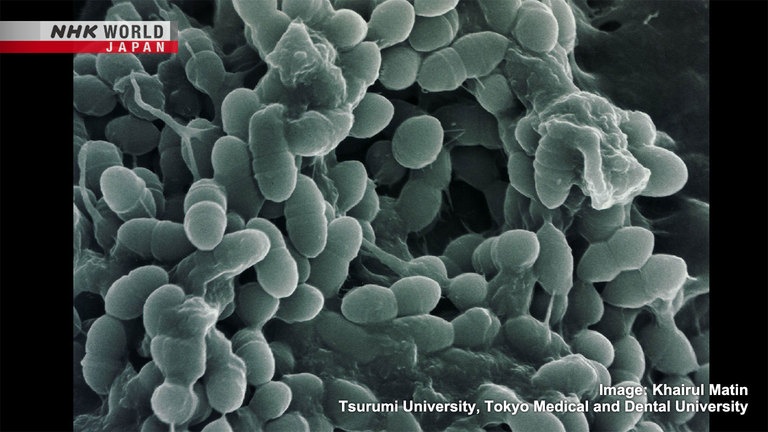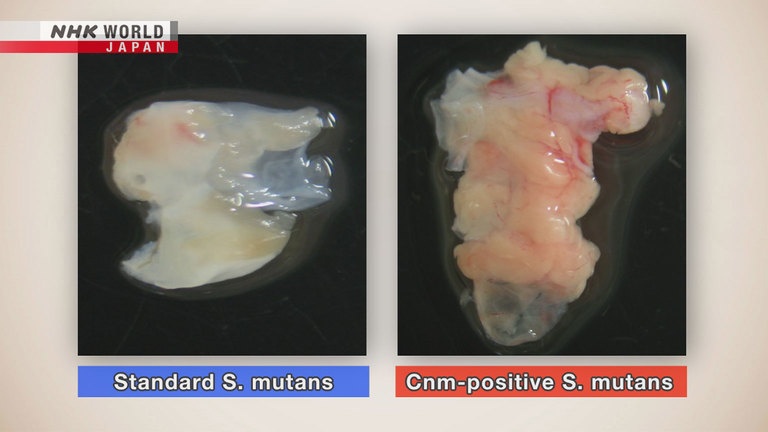Oral Bacteria: The Key to Health
Studies are revealing that some strains of bacteria in our mouths could contribute to heart and brain diseases, and even dementia. A researcher specializing in oral bacteria has developed a device to eliminate harmful bacteria that cannot be removed by brushing alone. Stay informed on the latest research on oral bacteria, which greatly impact overall health. Additionally, learn relaxation techniques through the traditional Japanese performing art of Noh.




Transcript
Join us as we explore Medical Frontiers.
In our mouths is a diverse variety of bacteria, often referred to as "oral flora,"
which resembles a field of blossoming flowers due to their various shapes and sizes.
Studies are revealing that these oral bacteria can be responsible for serious illnesses.
A 2022 article published in the science magazine Nature Communications
gained attention for linking oral bacteria to 28 lifestyle-related diseases,
including cardiovascular diseases and diabetes.
It is now well known that the bacteria that live in our gut can cause obesity, diabetes and other serious diseases.
And many of us try to enhance our good bacteria by eating foods such as yogurt or probiotics.
But our mouths are also full of bacteria.
And studies are revealing that they impact our whole body.
And prioritizing oral hygiene is critical for overall health.
Today on the program, we're going to introduce the latest research and initiatives on oral bacteria in Japan.
Experts estimate that our mouths harbor around 700 kinds of bacteria.
While we usually don't pay attention to them,
it is noteworthy that even 1 millimeter of saliva contains over 100 million bacteria,
meaning 100 billion to 150 billion bacteria flow from the mouth to the stomach and the intestines every day.
Hello. Thank you for your time today.
We spoke with Hanada Nobuhiro at Tsurumi University near Tokyo,
who has spent 40 years studying oral bacteria.
Let's examine the bacteria present in Erica's mouth to assess her oral health.
The result shows various bacteria, some of which can cause periodontal disease, commonly known as gum disease.
These bacteria reside in everyone's mouth, regardless of cleanliness.
During meals, food can stick to the surfaces of our teeth and gaps between them,
encouraging bacteria to multiply and form a mass called plaque.
Accumulated plaque can cause gums to recede and create pockets
where periodontal disease-causing bacteria enter, causing inflammation.
Severe cases could result in tooth loss.
This looks good.
Your mouth appears clean.
When dentists analyze samples, they focus on the bacteria's level of activity.
The periodontal disease-causing bacteria in Erica's mouth showed minimal activity,
suggesting a low risk of disease development.
This image shows a sample from a periodontal disease patient, with highly active, thin, long bacteria.
There are many bacteria moving in a spiral motion.
This indicates that periodontal
disease has progressed.
Periodontal disease-causing bacteria worsen gum inflammation,
generate inflammatory substances and enter blood vessels.
They circulate through the body, increasing the risk of various illnesses.
Additionally, recent studies show that cavity-causing bacteria
can also enter the bloodstream, triggering a range of diseases.
Dr. Hanada, in terms of the bacteria where do they actually live on the teeth or the mouth.
Cavity-causing bacteria first enter this area.
They cause cavities to form in these teeth.
The bacteria tend to inhabit
the area between the teeth as well.
Cavity-causing bacteria generate acid within plaque
that erodes the outer layer of the teeth and leads to cavities.
These bacteria then enter the bloodstream through these cavities and spread throughout the body.
How long does it take for them to go, for example, from the mouth into the bloodstream?
I mean what kind of amount of time are we talking.
It's surprisingly fast.
It only takes about 90 seconds.
A minute and a half.
From the mouth to the systemic circulation.
That's fast.
So, what are the most harmful strains of bacteria in the mouth?
When it comes to cavity-causing bacteria,
we focus on Streptococcus mutans.
Streptococcus mutans, commonly known as S. mutans,
is one of the most common cavity-causing bacteria.
Bacteria in the mouth fall into three categories:
good, bad and opportunistic.
S. mutans turns good bacteria into bad ones, advancing cavity formation.
Therefore, it is considered the most problematic strain among cavity-causing bacteria.
In healthy individuals, bacteria that enter the bloodstream
are usually eliminated by the immune system or through urine.
However, weakened immunity due to aging or other factors allows these bacteria to linger in the bloodstream,
posing risks to organs and blood vessels.
A group of researchers discovered in recent years
that S. mutans is one of the contributing factors to heart and brain diseases.
The team, led by Osaka University Professor Nakano Kazuhiko,
examined patients with endocarditis, or inflammation of the heart's inner layer.
This condition occurs when bacteria attach to the heart's walls or valves, leading to infection.
In severe cases, patients may need surgery to replace damaged heart valves with artificial ones.
Nakano and his colleagues focused on what's considered one of the most harmful strains of S. mutans
known as "cnm-positive S. mutans."
It possesses a gene called "cnm."
Examination of endocarditis patients revealed a high frequency of this strain of S. mutans in their mouths.
Nakano and his team decided to investigate the effects of it on endocarditis.
They conducted an experiment using two groups of rats:
one infected with the standard strain of S. mutans, and the other with cnm-positive S.mutans.
In this heart valve from a rat infected with the standard strain, there are no changes.
However, the valve of a rat infected with the more harmful strain has a lump of bacteria on it.
In this condition, the valve cannot function properly.
Nakano also investigated the connection between cnm-positive S.mutans and brain health.
Bleeding in the brain is a complication
of endocarditis, so we began studying
cerebral hemorrhage, a type of stroke.
This is a brain image of a patient with cnm-positive S.mutans.
The dark spots indicate small hemorrhages called cerebral microbleeds.
An image taken six months later shows this patient had suffered more of these brain bleeds.
The patient later had a stroke.
It was also discovered that stroke patients with the especially harmful strain
had 4.7 times as many cerebral microbleeds as patients without it.
Therefore, Nakano and the team examined the mechanism of brain hemorrhage caused by cnm-positive S. mutans.
They induced a mild brain hemorrhage in two groups of mice.
Then, they administered the standard S. mutans to one group,
and the more harmful strain to the other.
In the mice that received the standard strain, the bleeding did not progress.
But in the mice that were given the more harmful strain, the bleeding intensified.
The team also uncovered the mechanism by which cnm-positive S. mutans worsens bleeding in the brain.
Normally, when bleeding occurs, platelets bind to collagen to stop it.
However, the team discovered that if these more harmful bacteria are present in the bloodstream,
they bind to collagen before the platelets can,
preventing the formation of a clot to stop the bleeding.
These findings were published in a US medical journal in 2020, drawing significant attention.
The dentists and brain blood vessel specialists
we showed our studies to were skeptical.
But a neurosurgeon at a stroke meeting
showed interest, and offered to provide
saliva samples from their inpatients
for analysis of cavity-causing bacteria.
Nakano examined the prevalence of cnm-positive S. mutans in brain disease patients.
He found that 10 to 20 percent of people without brain disease had it.
Among cerebral infarction patients, around 40 percent had the strain,
and with cerebral hemorrhage patients, the figure was about 45 percent.
I had doubts whether the findings from the animal
experiments could be replicated in humans.
However, various studies have since
confirmed these findings in people,
leading to my confidence in the past 2 to 3 years.
This patient had cancer surgery two weeks ago.
He said he neglected his oral health in the past,
leaving cavities untreated until they became painful.
There's a gap between the tooth
at the back and the one next to it.
Please make sure to floss
and brush thoroughly.
At Osaka University, medical professionals provide oral care to patients with illnesses
such as cancer or heart disease, both before and after surgery.
It's reassuring to receive oral care.
I believe it's helping with my recovery.
I hear germs are harmful.
I appreciate the oral care I've been
getting before and after my surgery.
Researchers in Japan have been publishing many studies on the serious illnesses
associated with the bacteria that cause cavities and periodontal disease.
A research team at Kyushu University has identified a link
between periodontal disease-causing bacteria and Alzheimer's disease.
They found that injecting these bacteria into mice
led to the production of amyloid-beta in the liver and its accumulation in the brain.
This substance has been linked to the development of dementia.
Similarly, a team of researchers at Yokohama City University found
that periodontal disease-causing bacteria contribute to the development and progression of colorectal cancer.
The team analyzed the cancer tissue and saliva of 14 colorectal cancer patients.
Identical strains of these bacteria were found in both locations,
indicating a strong connection between the bacteria and colorectal cancer.
Now, let's explore ways to eliminate these bacteria from our mouths.
We sought advice from Hanada on proper dental care.
When brushing your teeth,
tilt your toothbrush at a 45-degree angle
and place it between your teeth.
Make sure the bristles fit tightly
between the teeth, without sliding.
If it slides, it's not fitting
properly between the teeth.
Hanada explained the consequences of not brushing your teeth.
Indiana University in the US conducted
an experiment with 50 volunteers.
They were 24 years old on average,
and healthy with clean teeth.
They were divided by race and gender and
told not to brush their teeth for 3 weeks.
3weeks?
56% of them developed endotoxemia.
Endotoxemia occurs when oral bacteria spread throughout the body,
producing a harmful substance called endotoxin that leads to inflammation.
In the experiment, the participants not only developed severe gingivitis,
or inflammation of the gums, but also had high levels of the toxin in their blood,
similar to patients undergoing artificial dialysis.
The participants had their teeth cleaned
by a dental hygienist immediately.
They also began brushing regularly at home.
A check-up 2 to 3 weeks later showed
their gingivitis had disappeared.
Brushing is important, but it can
clean only the tooth surfaces.
To clean the spaces between
the teeth, you need dental floss.
Flossing is important because dental decay
and gum disease tend to progress in those areas.
However, brushing and flossing may not be enough to eliminate bacteria completely.
Hanada has developed a unique device to tackle the problem.
The Dental Drug Delivery System, or "3DS," resembles mouthguards customized to fit a patient's teeth.
An anti-bacterial agent or disinfectant is applied inside the mouthguards.
Wearing these targets the harmful bacteria hiding between the teeth.
Patients used the 3DS for 5 minutes, twice a day, over 3 months.
The results showed a significant decrease in harmful bacteria from 2.6 percent to 1.5 percent.
Hanada's team is currently researching whether the use of 3DS
to remove harmful oral bacteria can help prevent a serious desease.
Inflammatory bowel disease, or IBD, causes inflammation in the lining of the intestines,
resulting in narrowing and in some cases, the development of cancer.
They did a study with 13 IBD patients whose conditions were under control.
After 3 months of 3DS, the periodontal inflammation in the gums of 12 patients
showed a positive trend toward improvement.
Hanada believes that the use of 3DS prevented periodontal disease-causing bacteria from reaching the intestines.
I don't think my mouth smells unpleasant anymore.
That's a positive outcome of this therapy.
Hanada's team is continuing their government-supported research
to explore further benefits to the 3DS therapy.
How often would you recommend seeing a dental hygienist?
It's best to go before plaque hardens into tartar.
Tartar removal involves scraping with a
metal device, which can damage the teeth.
I would suggest visiting every
3 months to prevent tartar buildup.
I'm sure everybody watching the program is going to be so motivated
to really prioritize their oral health.
Once oral bacteria enter the blood,
they affect every organ and function.
As research advances, this will become more
evident. I'm optimistic about future progress.
So thank you so much.
It's been an absolute pleasure.
Today on the program, we welcome the wonderful Noh actor
Mr. Yasuda who's going to give us some breathing exercises, which is based on Noh.
And I think the breathing particularly is such an important part of Noh,
an intrinsic part of Noh.
Human life of just 50 years is fleeting
compared with...
Noh is a traditional Japanese performing art with over 600 years of history.
Yasuda will teach us a breathing method using the time-honored techniques of Noh,
which can help us relax and better manage stress in our modern lives.
It's incredible how the output of your voice and the control of the voice—
No microphone.
I'm not exerting my throat.
So, you've got a relaxed throat?
Yes, I relax my whole body and breathe deeply.
But you don't look like you're breathing.
It's very— I can't see that you're breathing.
First, let's learn the proper posture for breathing.
When standing, the back of the knees
often tense up. Relax them gently.
Imagine your lower body being pulled toward the ground,
and your upper body being pulled
upward by a hook from the ceiling.
Keep your upper body relaxed.
You're in the midst of these 2 forces.
It looks like you're not having a lot of tension at all.
It's just that relaxation.
Next, let's learn a breathing technique.
Imagine holding the moon in front of you,
and let it enter your body.
Now, picture your whole body, from
top to bottom, within a large sphere.
Imagine being inside 2 spheres.
Visualize breathing in and out
from the soles of your feet.
Breathing through your feet.
Maintain the intention to inhale
and exhale from the soles of your feet.
Now, hold onto the moon again.
Breathe slowly, imagining the moon entering your body.
By continuing to breathe in this posture, you can release tension and relax your body.
Let's return to normal breathing.
Notice the sensation of your feet on the floor.
It feels like everything has slowed down.
I'm feeling so much more relaxed than I was 30 minutes ago.
The key to Noh vocalization is using your abdomen.
Feel the sensation of abdominal breathing.
Imagine holding a newspaper with one hand,
and punching through it with your other hand while vocalizing loudly.
Let's raise our voices. Ready, set, "Ha!"
But it's still coming from here.
I feel like it's not coming from here.
Remember to imagine exhaling
through your feet. Let's try again.
That's better.
The more you do this,
the more your body will relax.
Finally, let's use the breathing method as we try a passage from a famous Noh chant,
once performed by medieval Japanese warlords.
Human life of just 50 years is fleeting
compared with the passage of time in the universe.
It's so complex to do.
And I think coordinating the movements together with the breathwork and together with projecting the voice,
but it's so moving and so beautiful to watch.
So thank you so much.
The important thing is to relax.
Please continue with it.